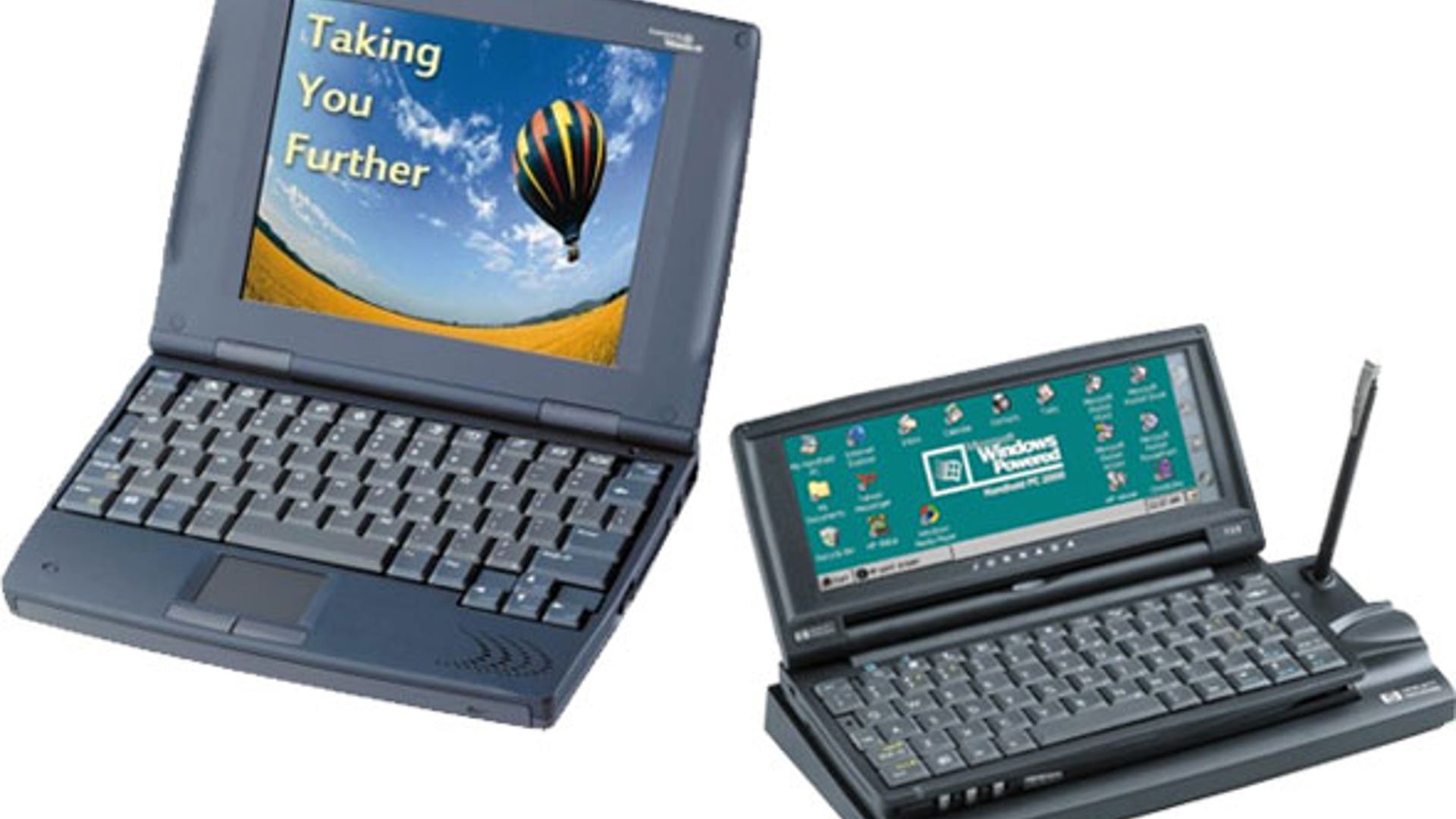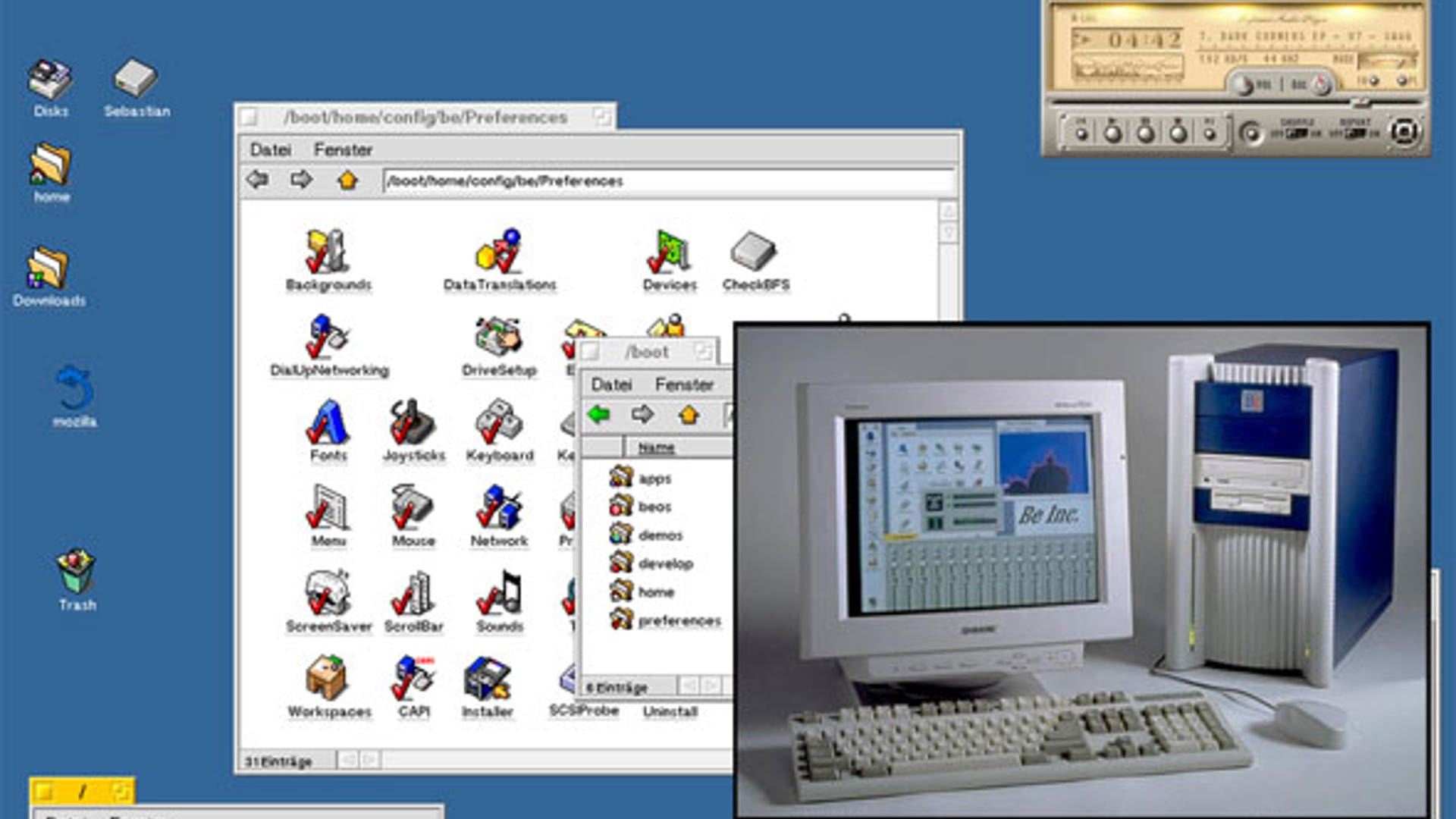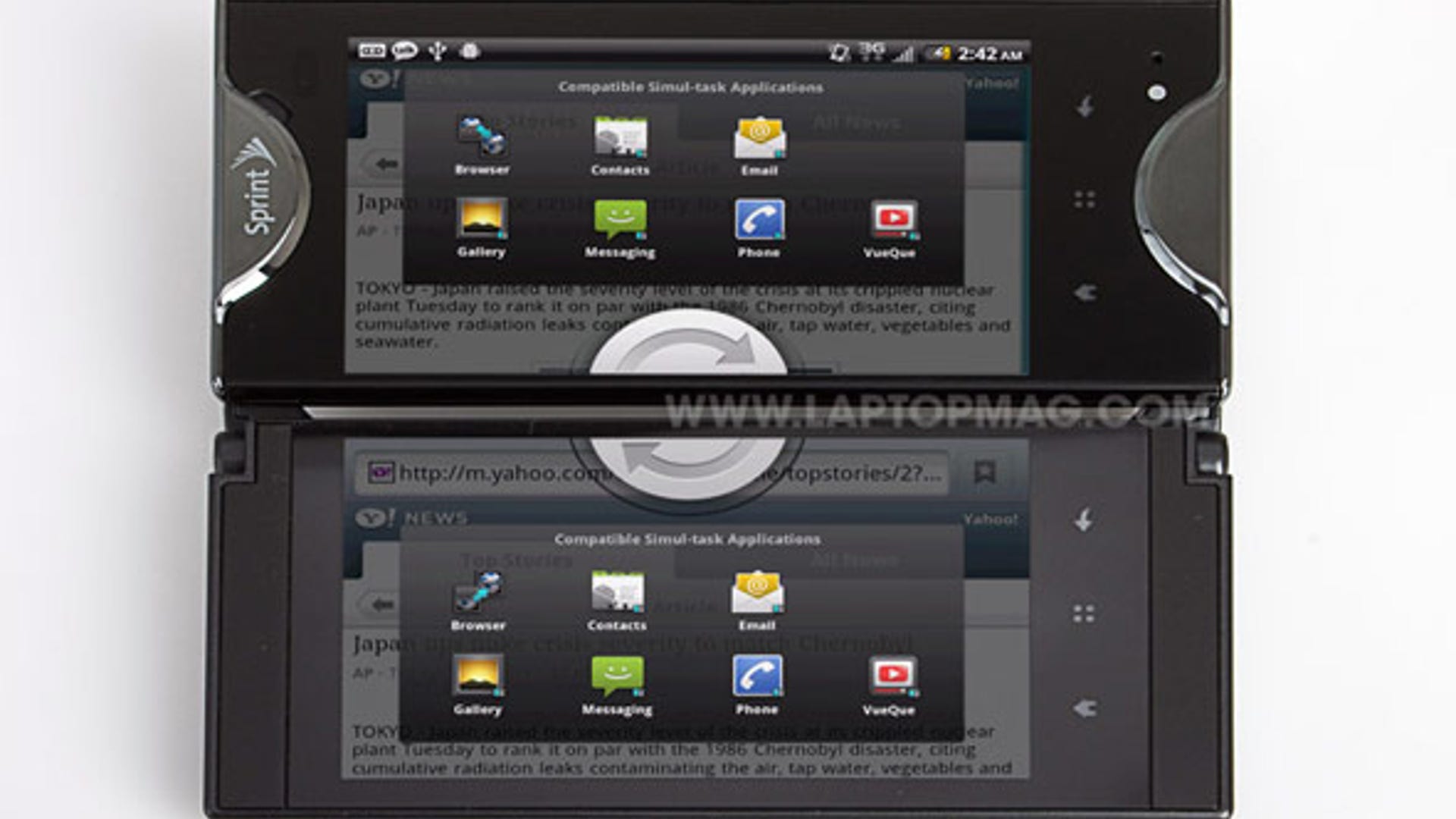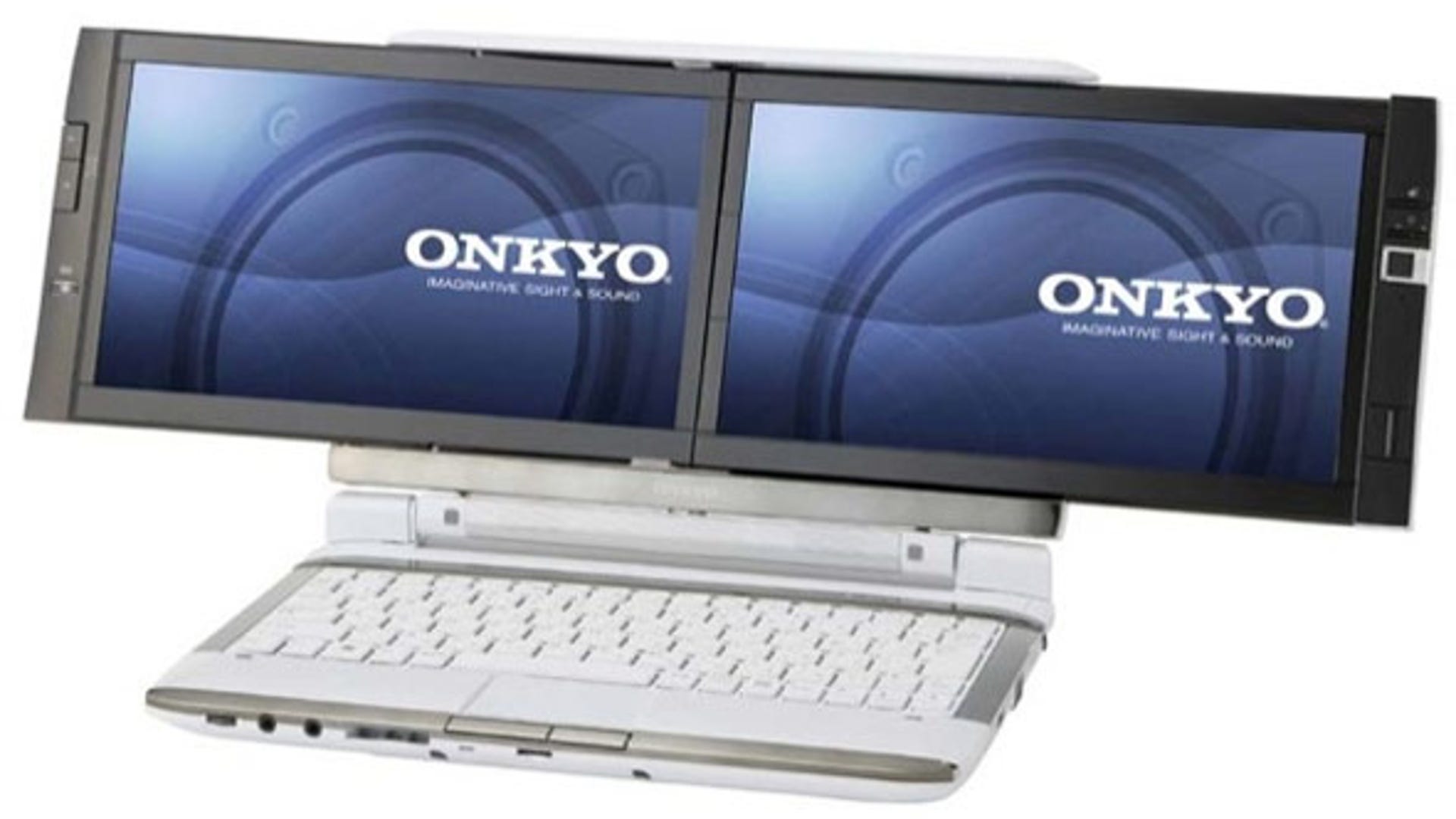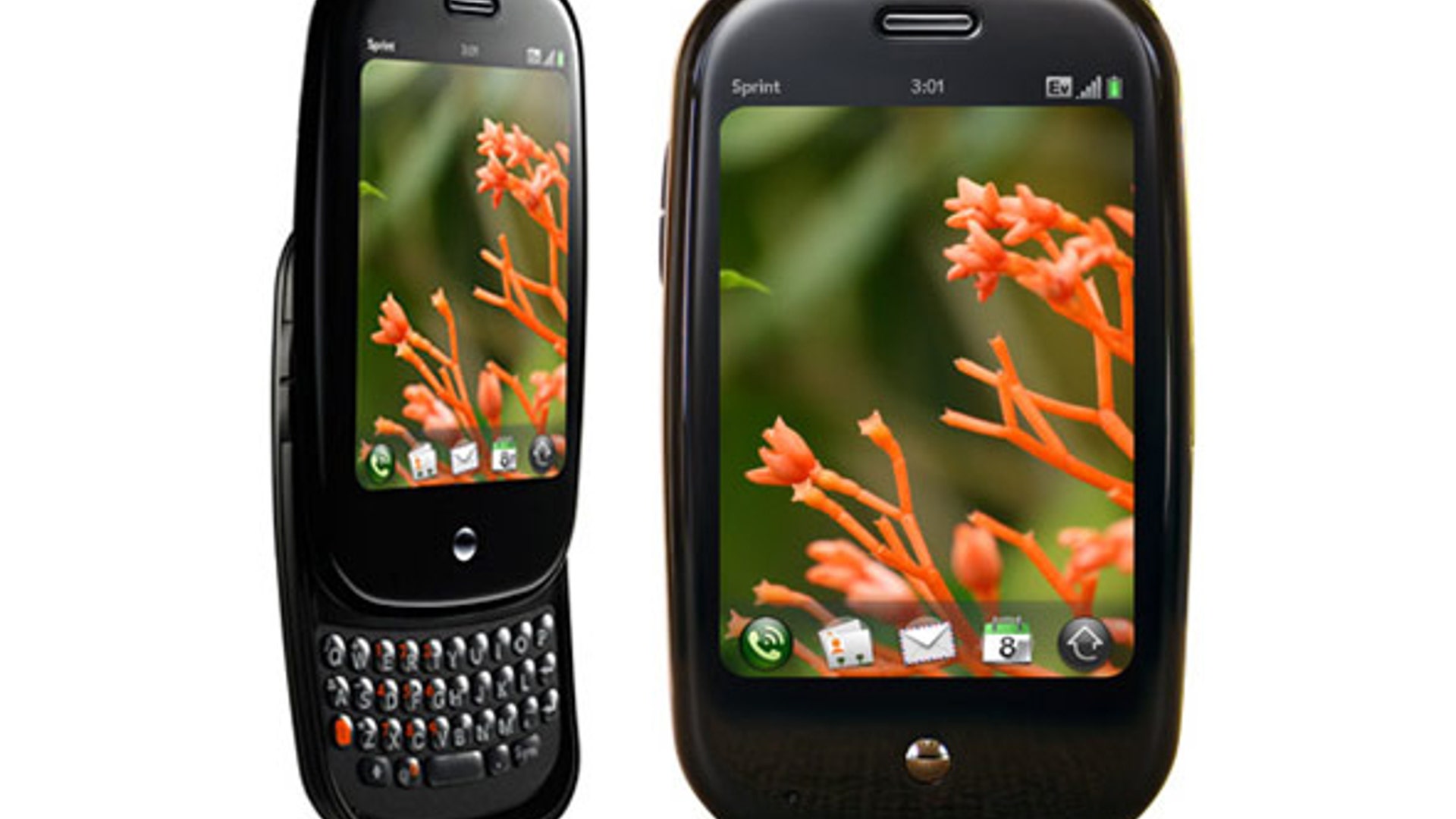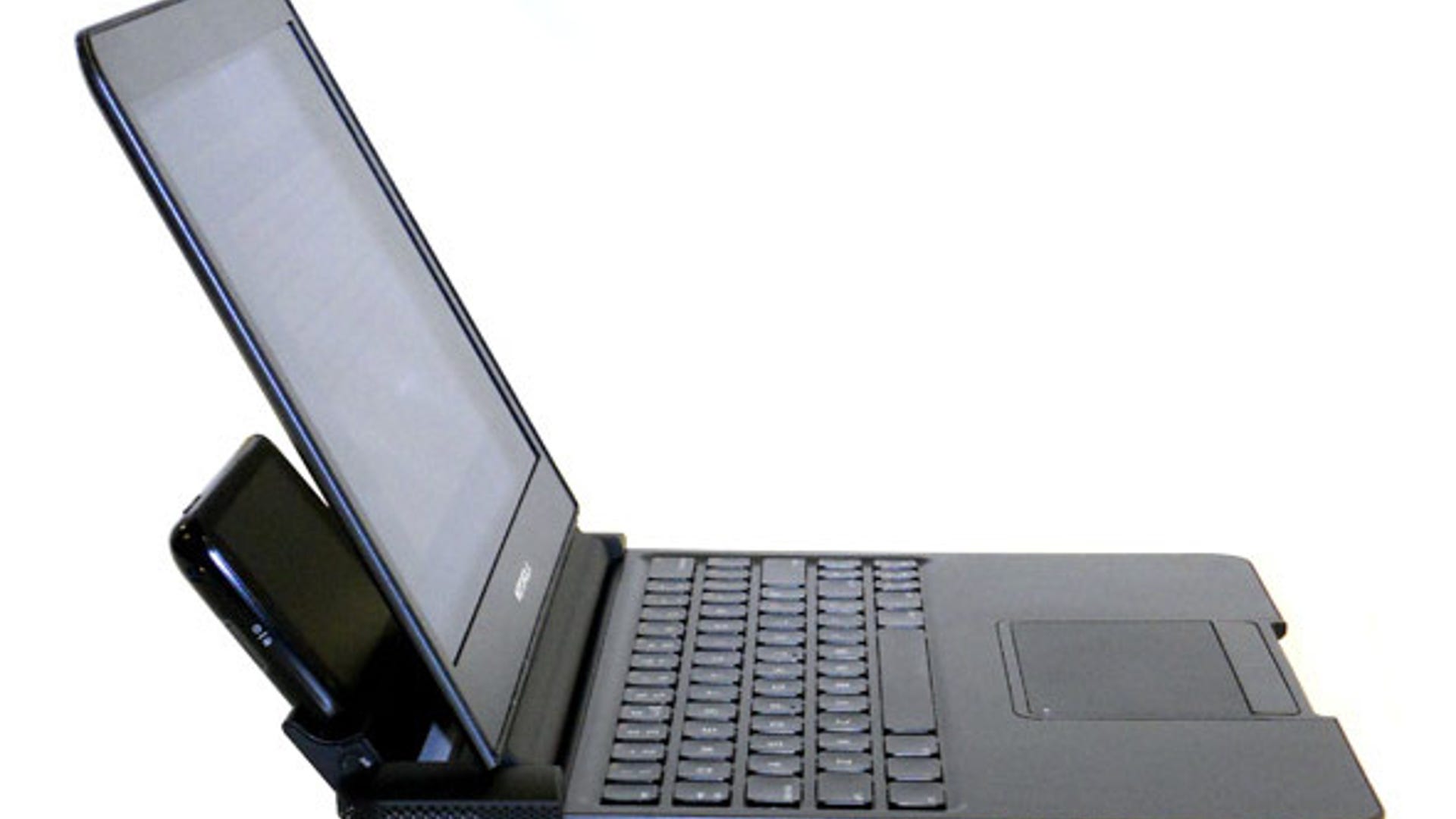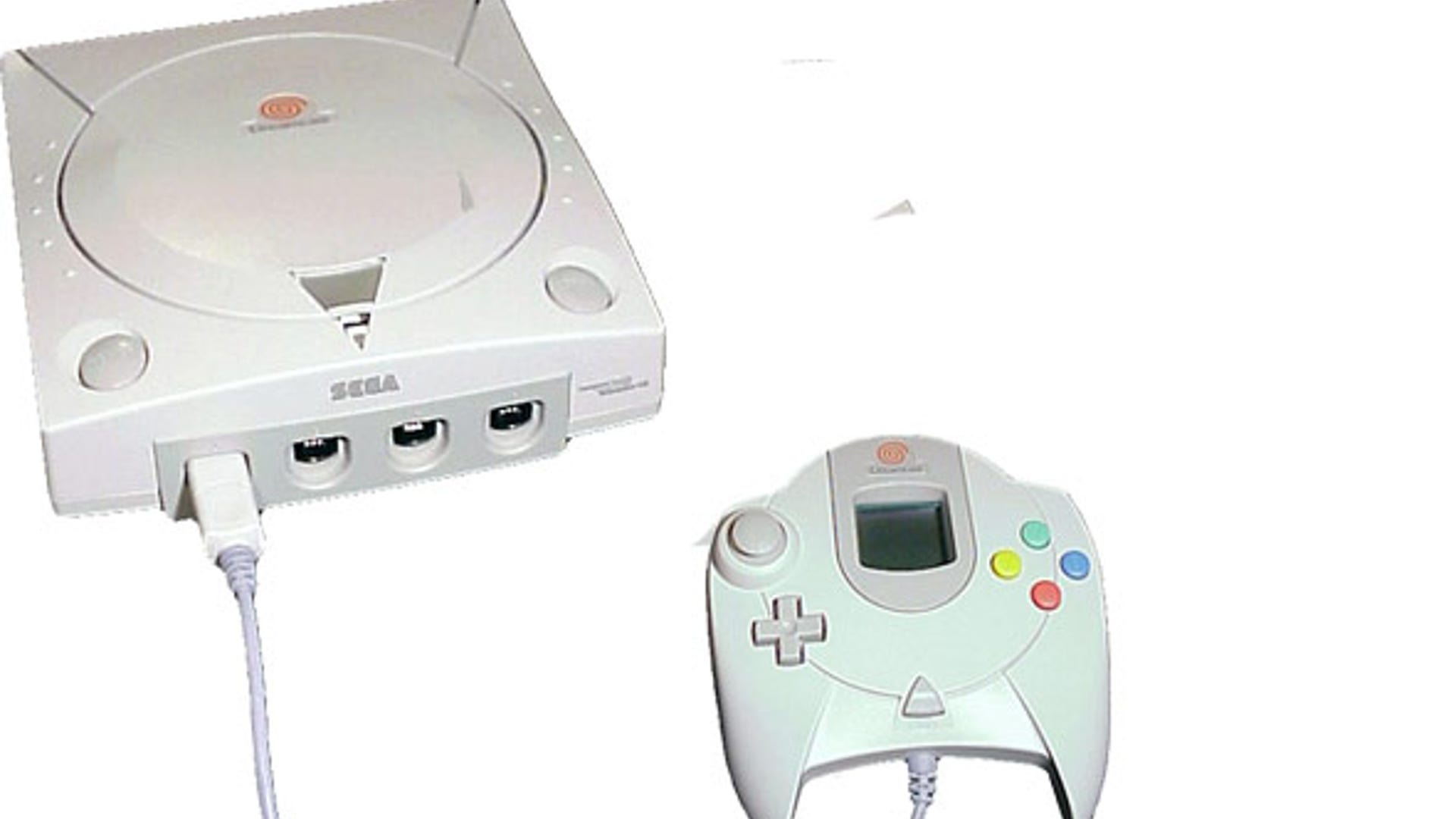Move Back
ADVERTISEMENT
Skip- Published12 Images
12 awesome gadgets that flopped
Somewhere in an alternate universe, the Earth 2 version of me is typing this article on a brand new Commodore Amiga sipping from a can of Crystal Pepsi when his Palm Pre 4 buzzes with a new CU-SeeMe video call. Unfortunately, in this universe, the best products don’t always win.
![viliv_n5]() Viliv N5 and Other UMPCs Sure, you love your smartphone, but can it run the full version of Microsoft Office or Photoshop? Toward the end of the last decade, a few intrepid manufacturers sold tiny 4- and 5-inch notebooks that weren’t much bigger than today’s supersized handsets. The best of these so-called UMPCs – short for Ultramobile PCs -- was 2010’s Viliv N5, which ran Windows 7 on its 1.3-GHz CPU and 4.8-inch, 1024 x 600 screen. With the 1-pound N5 in your pocket, you could write real programs, build websites, or edit docments, all on a clamshell device that fits in your pocket and sports a generously-sized QWERTY keyboard. Unfortunately, consumers focused their affections on shallow slates like the iPad. No more coding while standing on the subway for me, thanks to you. More from Laptop Mag: 15 Current Technologies We’ll Still Be Using in 2030 13 Tech Sounds You Don’t Hear Anymore 15 Gadgets My Son Won’t Useread moreLaptopMag.comShare
Viliv N5 and Other UMPCs Sure, you love your smartphone, but can it run the full version of Microsoft Office or Photoshop? Toward the end of the last decade, a few intrepid manufacturers sold tiny 4- and 5-inch notebooks that weren’t much bigger than today’s supersized handsets. The best of these so-called UMPCs – short for Ultramobile PCs -- was 2010’s Viliv N5, which ran Windows 7 on its 1.3-GHz CPU and 4.8-inch, 1024 x 600 screen. With the 1-pound N5 in your pocket, you could write real programs, build websites, or edit docments, all on a clamshell device that fits in your pocket and sports a generously-sized QWERTY keyboard. Unfortunately, consumers focused their affections on shallow slates like the iPad. No more coding while standing on the subway for me, thanks to you. More from Laptop Mag: 15 Current Technologies We’ll Still Be Using in 2030 13 Tech Sounds You Don’t Hear Anymore 15 Gadgets My Son Won’t Useread moreLaptopMag.comShare![apple_newton_slide]() Apple Newton The first and best of the PDAs, the Newton lasted only about 5 years and 8 models, but it made a lasting impact. Though the device got off to an inauspicious start, because of weak handwriting recognition, the quality and accuracy improved a great deal by the time Newton OS 2.0 was released in 1997. If the Newton had sold well enough to survive past 1998, it would have ended up going to color like its rival Palm did. Apple would have also likely entered the smartphone market long before 2007. Even better, Apple’s phones and tablets would be built to support pen input, something Steve Jobs opposed but is becoming quite popular with devices like the Samsung Galaxy Note II and LG Intuition. More from Laptop Mag: 15 Current Technologies We’ll Still Be Using in 2030 13 Tech Sounds You Don’t Hear Anymore 15 Gadgets My Son Won’t Useread moreLaptopMag.comShare
Apple Newton The first and best of the PDAs, the Newton lasted only about 5 years and 8 models, but it made a lasting impact. Though the device got off to an inauspicious start, because of weak handwriting recognition, the quality and accuracy improved a great deal by the time Newton OS 2.0 was released in 1997. If the Newton had sold well enough to survive past 1998, it would have ended up going to color like its rival Palm did. Apple would have also likely entered the smartphone market long before 2007. Even better, Apple’s phones and tablets would be built to support pen input, something Steve Jobs opposed but is becoming quite popular with devices like the Samsung Galaxy Note II and LG Intuition. More from Laptop Mag: 15 Current Technologies We’ll Still Be Using in 2030 13 Tech Sounds You Don’t Hear Anymore 15 Gadgets My Son Won’t Useread moreLaptopMag.comShare![ggg_hp_jornada]() HP Jornada and Other HPCs Google has been pushing its cloud-centric Chromebooks as the lightweight, long-lasting replacement for Windows laptops. But Microsoft spearheaded low-powered mini-notebooks way before they were cool. In the late 1990s, Microsoft and its OEM partners released 7 to 9-inch clamshell devices they called Handheld PCs. HPCs such as HP's Jornada line ran Windows CE, a scaled back version of Windows installed in ROM, while all local data was stored in solid state memory. Like today's tablets, HPCs woke up instantly and lasted many hours on a charge. Most didn’t have Wi-Fi built-in, but you could add it via a card. Sadly, consumers couldn’t grasp the value of HPC and they faded away. If more people bought great systems like the HP Jornada 820 or IBM ThinkPad Z50, the era of always-on computing would have started years ago. More from Laptop Mag: 15 Current Technologies We’ll Still Be Using in 2030 13 Tech Sounds You Don’t Hear Anymore 15 Gadgets My Son Won’t Useread moreLaptopMag/HPShare
HP Jornada and Other HPCs Google has been pushing its cloud-centric Chromebooks as the lightweight, long-lasting replacement for Windows laptops. But Microsoft spearheaded low-powered mini-notebooks way before they were cool. In the late 1990s, Microsoft and its OEM partners released 7 to 9-inch clamshell devices they called Handheld PCs. HPCs such as HP's Jornada line ran Windows CE, a scaled back version of Windows installed in ROM, while all local data was stored in solid state memory. Like today's tablets, HPCs woke up instantly and lasted many hours on a charge. Most didn’t have Wi-Fi built-in, but you could add it via a card. Sadly, consumers couldn’t grasp the value of HPC and they faded away. If more people bought great systems like the HP Jornada 820 or IBM ThinkPad Z50, the era of always-on computing would have started years ago. More from Laptop Mag: 15 Current Technologies We’ll Still Be Using in 2030 13 Tech Sounds You Don’t Hear Anymore 15 Gadgets My Son Won’t Useread moreLaptopMag/HPShare![ggg_bebox]() BeBox and BeOS On Earth 2, the sheer brilliance and beauty of BeOS caused both the OS and its BeBox PCs to displace both Windows and Mac OS years ago. In the 1990s, this BeOS's multithreading ability was so good that I could copy files off of my floppy disk without slowing the system. However, the best feature of this alternative OS was its clean and attractive GUI, complete with space-efficient title bars. In the mid-1990s, Be Inc. chairman Jean-Louis Gasse tried to sell his OS to Apple, but the two companies couldn't agree on a price. As a result, the Cupertino company bought Steve Jobs' NeXT and used NeXTSTEP rather than BeOS as the basis for Mac OS X. If only consumers had thought differently and bought more than 1,800 BeBoxes in total, this superior platform would have survived on its own. More from Laptop Mag: 15 Current Technologies We’ll Still Be Using in 2030 13 Tech Sounds You Don’t Hear Anymore 15 Gadgets My Son Won’t Useread moreLaptopMagShare
BeBox and BeOS On Earth 2, the sheer brilliance and beauty of BeOS caused both the OS and its BeBox PCs to displace both Windows and Mac OS years ago. In the 1990s, this BeOS's multithreading ability was so good that I could copy files off of my floppy disk without slowing the system. However, the best feature of this alternative OS was its clean and attractive GUI, complete with space-efficient title bars. In the mid-1990s, Be Inc. chairman Jean-Louis Gasse tried to sell his OS to Apple, but the two companies couldn't agree on a price. As a result, the Cupertino company bought Steve Jobs' NeXT and used NeXTSTEP rather than BeOS as the basis for Mac OS X. If only consumers had thought differently and bought more than 1,800 BeBoxes in total, this superior platform would have survived on its own. More from Laptop Mag: 15 Current Technologies We’ll Still Be Using in 2030 13 Tech Sounds You Don’t Hear Anymore 15 Gadgets My Son Won’t Useread moreLaptopMagShare![Kyocera_Echo_slide]() Kyocera Echo You can never be too rich, too thin or have too much screen real estate. Kyocera agreed back in 2011 when it launched the Echo, a dual-screened Android handset that let you use the two displays as one or use a nifty Simul-Task mode that allowed you to run a different app on each screen. You could also use the bottom panel as a keyboard. Unfortunately, the Echo fell on deaf ears and Sprint stopped selling the devie in the fall of 2011. We haven’t seen anything like it since. The phone lacked 4G and its design was bulky, but in a parallel universe where this phone was a runaway hit, all the handset makers now have dual-screen devices running Android 4.1 with LTE. More from Laptop Mag: 15 Current Technologies We’ll Still Be Using in 2030 13 Tech Sounds You Don’t Hear Anymore 15 Gadgets My Son Won’t Useread moreLaptopMag/KyoceraShare
Kyocera Echo You can never be too rich, too thin or have too much screen real estate. Kyocera agreed back in 2011 when it launched the Echo, a dual-screened Android handset that let you use the two displays as one or use a nifty Simul-Task mode that allowed you to run a different app on each screen. You could also use the bottom panel as a keyboard. Unfortunately, the Echo fell on deaf ears and Sprint stopped selling the devie in the fall of 2011. We haven’t seen anything like it since. The phone lacked 4G and its design was bulky, but in a parallel universe where this phone was a runaway hit, all the handset makers now have dual-screen devices running Android 4.1 with LTE. More from Laptop Mag: 15 Current Technologies We’ll Still Be Using in 2030 13 Tech Sounds You Don’t Hear Anymore 15 Gadgets My Son Won’t Useread moreLaptopMag/KyoceraShare![kohjinsha_slide]() Kohjinsha DZ Series Dual-Screen Notebook According to Microsoft research, adding a second screen increases your productivity by 9 to 50 percent. Unfortunately, when you hit the road with your laptop, you’re stuck with only one display. It didn't have to be that way. In 2009 Kohjinsha released its DZ Series, a notebook with two identically sized 10-inch screens that sat next to each other on top of its deck. The DZ, which was also sold as the Onkyo DX, was the ultimate multitasking device, but Japanese consumers didn't buy enough of them to keep the line going. While a new generation of portable USB monitors makes it easier to take a second screen with you, there’s nothing like having one built directly into your laptop. More from Laptop Mag: 15 Current Technologies We’ll Still Be Using in 2030 13 Tech Sounds You Don’t Hear Anymore 15 Gadgets My Son Won’t Useread moreLaptopMag/OnkyoShare
Kohjinsha DZ Series Dual-Screen Notebook According to Microsoft research, adding a second screen increases your productivity by 9 to 50 percent. Unfortunately, when you hit the road with your laptop, you’re stuck with only one display. It didn't have to be that way. In 2009 Kohjinsha released its DZ Series, a notebook with two identically sized 10-inch screens that sat next to each other on top of its deck. The DZ, which was also sold as the Onkyo DX, was the ultimate multitasking device, but Japanese consumers didn't buy enough of them to keep the line going. While a new generation of portable USB monitors makes it easier to take a second screen with you, there’s nothing like having one built directly into your laptop. More from Laptop Mag: 15 Current Technologies We’ll Still Be Using in 2030 13 Tech Sounds You Don’t Hear Anymore 15 Gadgets My Son Won’t Useread moreLaptopMag/OnkyoShare![palm_pre_lm]() Palm Pre Oh webOS, it seems to me that you lived your life like a candle in the wind. Your hardware burned out long before your software ever did. When it first launched on the Palm Pre in 2009, webOS and its attractive card-based interface were pregnant with possibility. The sleek-looking UI gained a cult-like following, and after HP acquired Palm, there was hope that webOS could be the next big mobile platform. HP even promised that the software would be pre-loaded on on all of its PCs! Unfortunately, the love affair between HP and webOS was over before you could say “Kardashian Marriage.” Just 49 days after it launched the first webOS tablet, the TouchPad, HP decided to kill all webOS hardware. If only more consumers had bought the Pre and Pre 2, the platform would be fighting for the number three platform today, instead of just Windows Phone 8 and BlackBerry. More from Laptop Mag: 15 Current Technologies We’ll Still Be Using in 2030 13 Tech Sounds You Don’t Hear Anymore 15 Gadgets My Son Won’t Useread moreLaptopMag/PalmShare
Palm Pre Oh webOS, it seems to me that you lived your life like a candle in the wind. Your hardware burned out long before your software ever did. When it first launched on the Palm Pre in 2009, webOS and its attractive card-based interface were pregnant with possibility. The sleek-looking UI gained a cult-like following, and after HP acquired Palm, there was hope that webOS could be the next big mobile platform. HP even promised that the software would be pre-loaded on on all of its PCs! Unfortunately, the love affair between HP and webOS was over before you could say “Kardashian Marriage.” Just 49 days after it launched the first webOS tablet, the TouchPad, HP decided to kill all webOS hardware. If only more consumers had bought the Pre and Pre 2, the platform would be fighting for the number three platform today, instead of just Windows Phone 8 and BlackBerry. More from Laptop Mag: 15 Current Technologies We’ll Still Be Using in 2030 13 Tech Sounds You Don’t Hear Anymore 15 Gadgets My Son Won’t Useread moreLaptopMag/PalmShare![Acer_Iconia_6120_slide]() Acer Iconia 6120 A tablet with two large screens. What could be better? How about a fully-functional Windows notebook with two 14-inch touch screens With the Acer Iconia 6120, you could choose to type on a large virtual keyboard, scribble notes on the bottom screen or fold the clamshell flat for a large tablet experience. Acer also included its slick Ring menu that appeared when users put five fingers on the screen. From there they could open the TouchBrowser (which stretched across both screens) and SocialJogger for showing social updates. Yes, this hybrid was expensive, but think about much better a thinner Windows 8 version would be. More from Laptop Mag: 15 Current Technologies We’ll Still Be Using in 2030 13 Tech Sounds You Don’t Hear Anymore 15 Gadgets My Son Won’t Useread moreLaptopMag/AcerShare
Acer Iconia 6120 A tablet with two large screens. What could be better? How about a fully-functional Windows notebook with two 14-inch touch screens With the Acer Iconia 6120, you could choose to type on a large virtual keyboard, scribble notes on the bottom screen or fold the clamshell flat for a large tablet experience. Acer also included its slick Ring menu that appeared when users put five fingers on the screen. From there they could open the TouchBrowser (which stretched across both screens) and SocialJogger for showing social updates. Yes, this hybrid was expensive, but think about much better a thinner Windows 8 version would be. More from Laptop Mag: 15 Current Technologies We’ll Still Be Using in 2030 13 Tech Sounds You Don’t Hear Anymore 15 Gadgets My Son Won’t Useread moreLaptopMag/AcerShare![commodore_amiga]() Commodore Amiga It’s hard to believe, but back in 1990 the Commodore Amiga gave Apple and Wintel a run for their money. This desktop had a sleek, 32-bit OS and both multimedia and multitasking abilities that were way ahead of their time. Amiga users were editing video when the rest of us were learning to play Solitaire with a mouse. However, by 1994, Commodore was out of business and Windows was the dominant OS. The company simply didn’t sell enough product. In an alternate universe, Amiga overtook Mac as the creative professional’s platform sometime around 1997 and now we're all using Amiga laptops to edit movies, lay out magazines, mix albums and retouch photos. More from Laptop Mag: 15 Current Technologies We’ll Still Be Using in 2030 13 Tech Sounds You Don’t Hear Anymore 15 Gadgets My Son Won’t Useread moreLaptopMagShare
Commodore Amiga It’s hard to believe, but back in 1990 the Commodore Amiga gave Apple and Wintel a run for their money. This desktop had a sleek, 32-bit OS and both multimedia and multitasking abilities that were way ahead of their time. Amiga users were editing video when the rest of us were learning to play Solitaire with a mouse. However, by 1994, Commodore was out of business and Windows was the dominant OS. The company simply didn’t sell enough product. In an alternate universe, Amiga overtook Mac as the creative professional’s platform sometime around 1997 and now we're all using Amiga laptops to edit movies, lay out magazines, mix albums and retouch photos. More from Laptop Mag: 15 Current Technologies We’ll Still Be Using in 2030 13 Tech Sounds You Don’t Hear Anymore 15 Gadgets My Son Won’t Useread moreLaptopMagShare![hp_omnibook]() HP Omnibook 300 Way back in 1993, HP released the Omnibook 300, a notebook with a built-in mouse that popped out of a compartment in the right side. As you used the lightweight mouse, it remained attached to the computer by a stick so you couldn’t lose it. Yes, it was a little awkward, because the mouse was so tiny and you couldn’t use it on your lap, but the idea was brilliant. If users had bought the Omnibook 300 in greater quantities, HP probably would have seen a mandate to continue developing the pop-out mouse on its notebooks. Somewhere on Earth 2, pop-out mice are offered on all of HP’s notebooks while competitors have introduced their own versions. More from Laptop Mag: 15 Current Technologies We’ll Still Be Using in 2030 13 Tech Sounds You Don’t Hear Anymore 15 Gadgets My Son Won’t Useread moreLaptopMag/HPShare
HP Omnibook 300 Way back in 1993, HP released the Omnibook 300, a notebook with a built-in mouse that popped out of a compartment in the right side. As you used the lightweight mouse, it remained attached to the computer by a stick so you couldn’t lose it. Yes, it was a little awkward, because the mouse was so tiny and you couldn’t use it on your lap, but the idea was brilliant. If users had bought the Omnibook 300 in greater quantities, HP probably would have seen a mandate to continue developing the pop-out mouse on its notebooks. Somewhere on Earth 2, pop-out mice are offered on all of HP’s notebooks while competitors have introduced their own versions. More from Laptop Mag: 15 Current Technologies We’ll Still Be Using in 2030 13 Tech Sounds You Don’t Hear Anymore 15 Gadgets My Son Won’t Useread moreLaptopMag/HPShare![Motorola_LapDock_slide]() Motorola Lapdock Today’s dual and quad-core smartphones offer the performance of a computer, so why not let them turn into one? In 2011, Motorola released its Lapdock, a 10-inch screen / keyboard / touchpad combo that transfored the Atrix Android phone into a notebook. The Lapdocks ran Webtop, a proprietary OS with limited functionality, but you could surf the full web via the Firefox browser. Later, Motorola beefed up its lineup with the 14-inch Lapdock 500, which added a full-size keyboard, better multitasking, and a built-in webcam. Sadly, Motorola announced this summer that it was discontinuing the entire Lapdock line. I wish Google and Motorola would have held on a bit longer to try a Lapdock powered by the Chrome OS. More from Laptop Mag: 15 Current Technologies We’ll Still Be Using in 2030 13 Tech Sounds You Don’t Hear Anymore 15 Gadgets My Son Won’t Useread moreLaptopMag/MotorolaShare
Motorola Lapdock Today’s dual and quad-core smartphones offer the performance of a computer, so why not let them turn into one? In 2011, Motorola released its Lapdock, a 10-inch screen / keyboard / touchpad combo that transfored the Atrix Android phone into a notebook. The Lapdocks ran Webtop, a proprietary OS with limited functionality, but you could surf the full web via the Firefox browser. Later, Motorola beefed up its lineup with the 14-inch Lapdock 500, which added a full-size keyboard, better multitasking, and a built-in webcam. Sadly, Motorola announced this summer that it was discontinuing the entire Lapdock line. I wish Google and Motorola would have held on a bit longer to try a Lapdock powered by the Chrome OS. More from Laptop Mag: 15 Current Technologies We’ll Still Be Using in 2030 13 Tech Sounds You Don’t Hear Anymore 15 Gadgets My Son Won’t Useread moreLaptopMag/MotorolaShare![dreamcast_slide]() Sega Dreamcast In the world of gaming consoles, the Sega Dreamcast is known as the one that got away. The first system to offer 128-bit graphics and modem connectivity, the 1999 Dreamcast marked SEGA’s last foray into the console business. After more consumers bought Sony’s PlayStation 2, Sega waved the white flag around the turn of the century. However, I can just imagine where the game industry would be today if Sega had made enough money to continue building hardware. Perhaps we’d be on the Dreamcast 3 or 4 by now, with features that really challenged both Microsoft and Sony for dominance. More from Laptop Mag: 15 Current Technologies We’ll Still Be Using in 2030 13 Tech Sounds You Don’t Hear Anymore 15 Gadgets My Son Won’t Useread moreLaptopMag/SegaShare
Sega Dreamcast In the world of gaming consoles, the Sega Dreamcast is known as the one that got away. The first system to offer 128-bit graphics and modem connectivity, the 1999 Dreamcast marked SEGA’s last foray into the console business. After more consumers bought Sony’s PlayStation 2, Sega waved the white flag around the turn of the century. However, I can just imagine where the game industry would be today if Sega had made enough money to continue building hardware. Perhaps we’d be on the Dreamcast 3 or 4 by now, with features that really challenged both Microsoft and Sony for dominance. More from Laptop Mag: 15 Current Technologies We’ll Still Be Using in 2030 13 Tech Sounds You Don’t Hear Anymore 15 Gadgets My Son Won’t Useread moreLaptopMag/SegaShare- Published12 Images
12 awesome gadgets that flopped
Somewhere in an alternate universe, the Earth 2 version of me is typing this article on a brand new Commodore Amiga sipping from a can of Crystal Pepsi when his Palm Pre 4 buzzes with a new CU-SeeMe video call. Unfortunately, in this universe, the best products don’t always win.
Move Forward
- 12 awesome gadgets that flopped












Thumbnail View
Image 0 of 12


